
British postcard in the Picturegoer Series, London, no. 100.
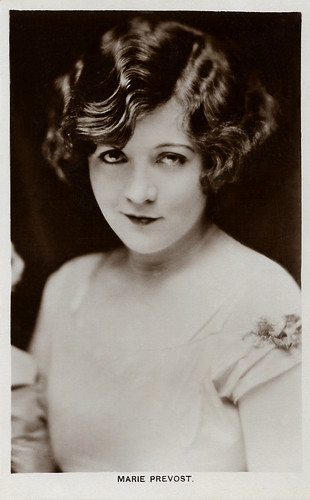
British postcard in the Picturegoer Series, London, no. 100a.
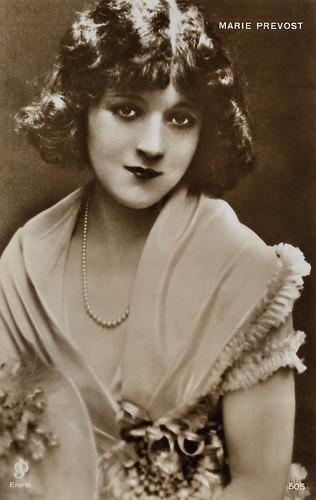
Swedish postcard by Eneret B.C. & A.H., no. 505.

Belgian postcard by P.I.A. Belga phot, Bruxelles, no. 37. Photo: Metro-Goldwyn-Mayer.
A French bathing beauty born in Canada
Marie Prevost was born in 1896 in Sarnia, Ontario, Canada, as Mary Bickford Dunn, the daughter of Hughina Marion née Bickford (or McDonald the sources are not sure) and Arthur 'Teddy' Dunn, a railroad conductor. In 1897, when she was an infant, Teddy Dunn was killed when gas seeped into the St. Clair Tunnel. Hughina later married Frank Prevost and the family moved to the U.S. First, the Dunn family settled in Denver, Colorado, then in Los Angeles.
While living in Los Angeles, Prevost attended Manual Arts High School. By 1915, Prevost landed a job as a secretary at a law firm that represented the Keystone Film Company. While running an office errand at the Keystone Studios, Prevost was asked to appear in a bit part for the film His Father's Footsteps. Mack Sennett, Keystone's owner and also of Canadian origin, was impressed and entrusted her with the role of an exotic 'French girl'. He inserted her into his Bathing Beauties, with the stage name of Marie Prevost.
In 1918, Marie was secretly married to Henry Charles 'Sonny' Gerke, a young man from high society, but the marriage failed after only six months because Gerke did not have the courage to tell his mother that he had married an actress. Fearful of the bad publicity resulting from a divorce, Marie remained married until 1923, always keeping everyone unaware of her marriage.
Prevost's first lead role was in Yankee Doodle in Berlin (1919). The film was a hit and helped to solidify Prevost's career. Another success was Love, Honor, and Behave (F. Richard Jones, Erle Kenton, 1920), alongside another Sennett protégé, George O'Hara. A series of small roles followed in which she played the part of the young, innocent sexy girl.
In 1921, Marie signed a contract with Universal after getting the attention of Irving Thalberg. Thalberg decided to make her a star and organised a great advertising hype for her. He announced that Marie would star in two films, The Moonlight Follies (King Baggot, 1921) and Kissed (King Baggot, 1922), and sent her to Coney Island. There the actress publicly burned her bathing suit, signifying the end of her "bathing" days.
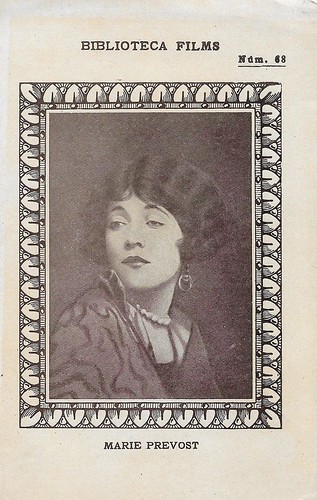
Spanish collectors card by Biblioteca Films, no. 68.

Spanish postcard by La Novela Semanal Cinematográfica, no. 13.
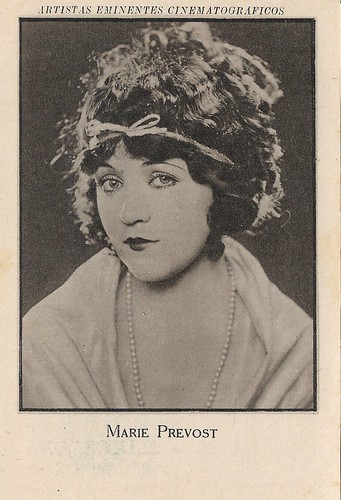
Spanish collectors card in the Artistas eminentes cinematograficos by Chocolates Jaime Boix, Barcelona, series VIII, no. 14 of 20.

Spanish collectors card by Chocolate E. Juncosa, Barcelona, series 1, no. 1.
Underplaying comedy to achieve the maximum effect
At Universal, Marie Prevost only got light comedy roles. When the contract expired, Jack Warner signed her for Warner Bros, recognizing $ 1,500 a week.
Alongside actor Kenneth Harlan as Tony, Marie played Gloria in The Beautiful and the Damned (Sidney Franklin, 1922), based on F. Scott Fitzgerald's bestseller on two idle spendthrifts who do not know how to cope with money running out.
To publicise the film, the production company announced that the actors would get married during filming on the set. The advertising launch worked and the studios were flooded with letters and gifts for the spouses. But when in the Los Angeles Mirror the story of Prevost's earlier secret marriage appeared: "Marie Prevost will become bigamist if she marries Harlan", Warner immediately took charge of the annulment of that marriage, so Harlan and Marie could marry.
Despite the bad publicity, The Beautiful and Damned was successful. By consequence, Ernst Lubitsch wanted Marie as the beautiful seductress in The Marriage Circle (1924), with Adolphe Menjou, Florence Vidor, and Monte Blue. Lubitsch said that Prevost was one of the few actresses in Hollywood who knew how to underplay comedy to achieve the maximum effect. She was a favourite of Lubitsch who cast her in three of his comedy films: The Marriage Circle (1924), Three Women (1924) and Kiss Me Again (1925).
At Warner's in the mid-1920s, Prevost would star in comedies and dramas with Harrison Ford (the silent actor), Monte Blue, Matt Moore, Douglas Fairbanks Jr., and Kenneth Harlan.

Italian postcard in the '100 Artisti del Cinema' series by Edizione ELAH 'La Casa delle caramelle', no. 99. Photo: Warner Bros.

French postcard by Cinémagazine-Edition, no. 242.

Romanian postcard. Photo: Cawa-Film / Christie Film. Harrison Ford and Marie Prevost in the comedy Up in Mabel's Room (E. Mason Hopper, 1926). The Romanian title 'Buduarul doamnei' translates as 'A Lady's Boudoir'. Plot: Mabel (Prevost) catches her husband (Ford) buying lingerie, and he won't explain who it's for. She divorces him but later learns he was buying her an anniversary gift. She becomes determined to win him back.

Austrian postcard by Iris-Verlag, no. 5618. Photo: PMC / Verleih Mondial.
A brief but fatal relationship with Howard Hughes
In 1926, Warner decided not to prolong the contracts of Harlan and Marie Prevost. The Canadian actress also lost her mother, who, in a car with actress Vera Steadman and producer Al Christie, was killed in an accident in Florida. Hughina was crushed by the vehicle and died at the scene. Steadman and Christie sustained serious injuries but survived.
Devastated by her mother's death and losing her work, Marie's marriage deteriorated. She began to drink and soon slipped into alcoholism. In 1927, she separated from her second husband, and despite a reconciliation in between, she divorced him altogether in 1929.
To overcome the crisis, Prevost threw herself completely at work. After seeing her in The Beautiful and Damned, in 1928 Howard Hughes wanted her to star in The Racket (Lewis Milestone, 1928) with Thomas Meighan. The two had a brief relationship but Hughes soon left her and Marie fell into a deepening depression. The Racket was nominated for the Academy Award for Best Picture (then called Outstanding Picture) in the 1929 Academy Awards.
The Racket would be her last feature film. Marie began to gain weight and could no longer control either food or alcohol. In 1934 her financial situation became dramatic. To find work again, she faced drastic diets that further weakened her. Hal Erickson at AllMovie: "Talking pictures forced Prevost to alter her image; her nasal, high-pitched voice was more suited to wisecracking chorus girls or gum-chewing receptionists than pampered society wives. Prevost was cast in a few good supporting parts throughout the '30s, notably as Carole Lombard's manicurist chum in Hands Across the Table (Mitchell Leisen, 1936). " She made her last onscreen appearance in 1936.
In 1937, Marie Prevost died of a heart attack due to malnutrition and acute alcoholism. She was 40. Her body was found only two days later, due to the continuous and insistent barking of her pet dachshund Maxie. A bellhop came into the house and found her lying face down on the bed, legs marked by the teeth of her dog, which had tried to wake her by biting her. Prevost's death was featured in the book 'Hollywood Babylon' by Kenneth Anger. Anger falsely claims Prevost's dog made "mincemeat out of his mistress", but while Maxie did bite her legs in an effort to wake her, the dog did not attempt to eat her body.
Prevost's estate was valued at $300 since she had squandered most of her earnings. The funeral at the Memorial Cemetery in Hollywood was paid for by Joan Crawford: in addition to Crawford, Clark Gable, Wallace Beery and Barbara Stanwyck participated. Her poor case prompted the Hollywood community to create in the early 1940s the Motion Picture & Television Country House and Hospital to provide medical care for employees of the television and motion picture industry.

French postcard by A.N., Paris in the Les vedettes de cinéma, series, no. 1. Photo: Universal Film.

German postcard by Ross Verlag, no. 4467/1, 1929-1930. Collection: Geoffrey Donaldson Institute.

Polish postcard by Polonia, Krakow, no. 455.
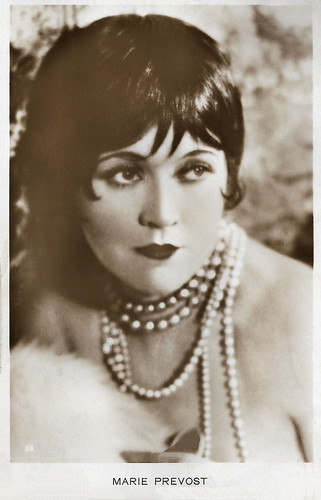
British Real Photograph postcard, no. 84. Sent by mail in 1929.
Sources: Hal Erickson (AllMovie), Stacia Kissick Jones (She blogged by night), Wikipedia (Italian and English), and IMDb.
No comments:
Post a Comment